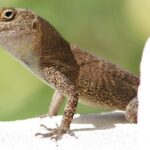
- Scientific name : Anolis cristatellus (Duméril et Bibron, 1837)
- Local name : Crested anole, Puerto Rican crested anole, Common Puerto Rican anole.
- Order : Dactyloidae
- Family : Squamata
Description
Morphology. Medium sized anole. The body colour is usually brown, with a lighter yellow-green colour on the ventral side. The head varies from brown to grey-green. Juveniles frequently show a clear dorsal stripe, sometimes preserved in adult females. The throat is whitish and the dewlap is greenish edged with orange-red, or completely yellowish or dark orange. The main characteristic feature is a laterally compressed tail with, in males, a permanently erected crest, extending to the neck. The height of this crest is higher along the tail and the neck than on the back. The iris is dark brown (Powell et al. 2015).
Standard body size (snout-vent length). males: up to 69 mm; females: 38 to 58 mm (Hahn and Köhler, 2010; Hall and Warner, 2017; Chejanovski et al., 2017).
Sexual dimorphism. Females are smaller than males, and do not have a dorsocaudal crest (Hahn and Köhler, 2010).
Variations. The body colour of the same individual can vary from light grey, reddish brown to black, depending on its physiological condition.
The size (total length and relative size of the legs) of individuals inhabiting urban environments is on average greater than that of individuals inhabiting natural environments, regardless of sex (Winchell et al., 2016; Hall and Warner, 2017; Chejanovsky et al., 2017; Thawley et al., 2019).
The dewlap colour is darker in populations inhabiting forested habitats than in populations inhabiting open habitats (Leal and Fleishman, 2004).
In Puerto Rico, the size of the caudal crest varies depending on the region. Moreover, within the same region, the caudal crest is systematically higher in urban areas than in natural forested areas (Prado-Irwin et al., 2019).
Possible confusion with other species. Confusion is possible with other anole species having a dorsal crest. However, this crest is always erected in Anolis cristatellus.
Distribution
Native. Puerto Rico (including several satellite islets), Vieques, Culebra, Culebrita, American and British Virgin Islands.
Introduced. Florida (Kolbe et al., 2007; Krysko et al., 2009; Lawson et al., 2019), Costa Rica.
Caribbean: Dominican Republic (Fitch et al., 1989; Kolbe et al., 2007), Saint Martin / Sint Maarten (Breuil et al., 2009; Yokoyama, 2012), Dominica (Malhotra et al., 2007; Ackley et al., 2009; Eales et al., 2010), Trinidad (Auguste et al., 2018).
Biology and ecology
Habitat. Anolis cristatellus can cope with a great diversity of natural and anthropized habitats. In natural environment, the species is particularly present in dry and mesophilic forests, and rather rare in humid forests. A. cristatellus also occur in disturbed and rural environments, as well as in urban areas (Winchell et al., 2016).
Bioclimatic niches modelled for native (Puerto Rico) and introduced populations in Miami and Key Biscayne (Florida) demonstrated the ability of the species to adapt to lower temperatures than those represented in its native range (Kolbe et al., 2012; Leal and Gunderson, 2012).
Diet. Mainly insectivore and carnivore (small vertebrates and juvenile anoles) (Kelehear and Graham, 2015; Drakeley et al., 2015; Campbell et al., 2018). Can also feed on fruits, berries and flowers.
Reproduction. Reproductive cycle of the females is seasonal, and the majority of reproductions happen during the wet season (Gorman et Licht, 1974; Otero et al., 2015). However, the rate of reproductive females is variable depending on the habitat, with the proportion of breeding females throughout the year being higher in open (urban) habitats than in closed (forest) environments (Gorman and Licht , 1974; Otero et al., 2015). These differences are also observed at the micro-habitat scale (Otero et al., 2015).
Females can mate with multiple males, and store sperm for up to 84 days. Like all anolis species, A. cristatellus lays a single egg, deposited under leaves or debris. The eggs of several females can be deposited in the same place. Several eggs can be laid, at two-weeks intervals, when conditions are favourable (Eales et al. 2008; Eales et al. 2010).
Behaviour. A. cristatellus is a territorial species. Males may use several visual signals, such as dewlap extensions, head-bobbing and push-ups, in order to defend their territory, or when looking for a breeding partner (Leal and Rodriguez-Robles, 1997). These signals are also used to disturb and dissuade predators (Leal and Rodriguez-Robles, 1995, 1997).
Impact and management of introduced populations
Impact. The impact of Anolis cristatellus on native ecosystems of introduced regions remains poorly documented.
In Dominica, the sympatric presence of A. cristatellus with the native species A. oculatus resulted in a character displacement: A. oculatus shifted to higher heights in vegetation, and presented shorter limbs than when the species occurred alone (Dufour et al., 2018).
Management. To date, no targeted control measures have been established in the different regions where the species has been introduced.
Bibliographie
- Ackley, J. W., Muelleman, P. J., Carter, R. E., Henderson, R. W., & Powell, R. (2009). A rapid assessment of herpetofaunal diversity in variously altered habitats on Dominica. Applied Herpetology, 6, 171–184.
- Auguste, R. J., Dass, K., & Baldeo, D. (2018). Discovery of the Puerto Rican Crested Anole, Anolis cristatellus Duméril & Bibron, on Trinidad. Caribbean Herpetology, 63, 1–2.
- Breuil, M., Guiougou, F., Questel, K., & Ibéné, B. (2009). Modifications du peuplement herpétologique dans les Antilles françaises : disparitions et espèces allochtones. 2ème partie : Reptiles. Le Courrier de La Nature, 251, 36–43.
- Campbell, N., Thawley, C. J., & Stroud, J. T. (2018). Anolis cristatellus (Puerto Rican Crested Anole). Cannibalism. Herpetological Review, 49, 115–116.
- Chejanovski, Z. A., Avilés-Rodríguez, K. J., Lapiedra, O., Preisser, E. L., & Kolbe, J. J. (2017). An experimental evaluation of foraging decisions in urban and natural forest populations of Anolis lizards. Urban Ecosystems, 20, 1011–1018.
- Drakeley, M., Lapiedra, O., & Kolbe, J. J. (2015). Predation risk perception, food density and conspecific cues shape foraging decisions in a tropical lizard. PLoS ONE, 10, 1–16.
- Dufour, C. M. S., Clark, D. L., Herrel, A., & Losos, J. B. (2020). Recent biological invasion shapes species recognition and aggressive behaviour in a native species: a behavioural experiment using robots in the field. Journal of Animal Ecology, 89, 1604–1614.
- Dufour, C. M. S., Herrel, A., & Losos, J. B. (2018). Ecological character displacement between a native and an introduced species: the invasion of Anolis cristatellus in Dominica. Biological Journal of the Linnean Society, 123, 43–54.
- Eales, J., Thorpe, R. S., & Malhotra, A. (2008). Weak founder effect signal in a recent introduction of Caribbean Anolis. Molecular Ecology, 17, 1416–1426.
- Eales, J., Thorpe, R. S., & Malhotra, A. (2010). Colonization history and genetic diversity: adaptive potential in early stage invasions. Molecular Ecology, 19, 2858–2869.
- Fitch, H. S., Henderson, R. W., & Guarisco, H. (1989). Aspects of the ecology of an introduced anole: Anolis cristatellus in the Dominican Republic. Amphibia Reptilia, 10, 307–320.
- Gorman, G C Licht, P. (1974). Seasonality in ovarian cycles among tropical anolis lizards. Ecological Society of America, 55, 360–369.
- Hahn, M., & Köhler, G. (2010). Morphological variation in Anolis cristatellus. Salamandra, 46, 117–120.
- Hall, J. M., & Warner, D. A. (2017). Body size and reproduction of a non-native lizard are enhanced in an urban environment. Biological Journal of the Linnean Society, 122, 860–871.
- Kelehear, C., & Graham, S. P. (2015). Anolis cristatellus (Crested Anole). Diet. Herpetological Review, 46, 431.
- Kolbe, J. J., Glor, R. E., Schettino, L. R., Lara, A. C., Larson, A., & Losos, J. B. (2007). Multiple sources, admixture, and genetic variation in introduced Anolis lizard populations. Conservation Biology, 21, 1612–1625.
- Kolbe, J. J., VanMiddlesworth, P. S., Losin, N., Dappen, N., & Losos, J. B. (2012). Climatic niche shift predicts thermal trait response in one but not both introductions of the Puerto Rican lizard Anolis cristatellus to Miami, Florida, USA. Ecology and Evolution, 2, 1503–1516.
- Krysko, K. L., Enge, K. M., Donlan, E. M., Golden, E. A., Burgess, J. P., & Larson, K. W. (2009). The non-marine herpetofauna of Key Biscayne, Florida. Herpetological Conservation and Biology, 5, 132–142.
- Lawson, G. R., Norden, A. W., & Rothermel, B. B. (2019). Geographic distribution. Anolis cristatellus (Crested Anole). USA: Florida. Herpetological Review, 50, 524.
- Leal, M., & Fleishman, L. J. (2004). Differences in visual signal design and detectability between allopatric populations of Anolis lizards. American Naturalist, 163, 26–39.
- Leal, M., & Gunderson, A. R. (2012). Rapid change in the thermal tolerance of a tropical lizard. American Naturalist, 180, 815–822.
- Leal, M., & Rodriguez-Robles, J. A. (1997). Signalling displays during predator-prey interactions in a Puerto Rican anole, Anolis cristatellus. Animal Behaviour, 54, 1147–1154.
- Losos JB, 2009. Lizards in an evolutionary tree. Berkeley, California, USA: University of California Press, 512
- Malhotra, A., Thorpe, R. S., Hypolite, E., & James, A. (2007). A report on the status of the herpetofauna of the commonwealth of Dominica, West Indies. Applied Herpetology, 4, 177–194.
- Nicholson, K. E., Crother, B. I., Guyer, C., & Savage, J. a Y. M. (2012). It is time for a new classification of anoles (Squamata: Dactyloidae). Zootaxa, 3477, 1–108.
- Nicholson, K. E., Crother, B. I., Guyer, C., & Savage, J. M. (2018). Translating a clade based classification into one that is valid under the international code of zoological nomenclature: the case of the lizards of the family Dactyloidae (Order Squamata). Zootaxa, 4461, 573–586.
- Otero, L. M., Huey, R. B., & Gorman, G. C. (2015). A few meters matter: Local habitats drive reproductive cycles in a tropical lizard. American Naturalist, 186, E72–E80.
- Poe, S., Nieto-Montes De Oca, A., Torres-Carvajal, O., De Queiroz, K., Velasco, J. A., Truett, B., … Ian Latella, A. (2017). A phylogenetic, biogeographic, and taxonomic study of all extant species of anolis (Squamata; Iguanidae). Systematic Biology, 66, 663–697.
- Powell R., Henderson R. W., Parmerlee Jr. J. S. (2015). The reptiles and amphibians of the Dutch Caribbean: Saba, St. Eustatius, and St. Maarten. Bonaire, Dutch Caribbean: Dutch Caribbean Nature Alliance, 343
- Prado-Irwin, S. R., Revell, L. J., & Winchell, K. M. (2019). Variation in tail morphology across urban and forest populations of the crested anole (Anolis cristatellus). Biological Journal of the Linnean Society, 128, 632–644.
- Thawley, C. J., Moniz, H. A., Merritt, A. J., Battles, A. C., Michaelides, S. N., & Kolbe, J. J. (2019). Urbanization affects body size and parasitism but not thermal preferences in Anolis lizards. Journal of Urban Ecology, 5, 1–9.
- Winchell, K. M., Reynolds, R. G., Prado-Irwin, S. R., Puente-Rolón, A. R., & Revell, L. J. (2016). Phenotypic shifts in urban areas in the tropical lizard Anolis cristatellus. Evolution, 70, 1009–1022.
- Yokoyama, M. (2012). Reptiles and Amphibians introduced on St. Martin, Lesser Antilles. Reptiles & Amphibians, 19, 271–279.





